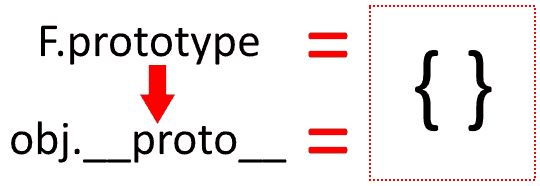OOP in prototype style in JavaScript
As we know, there are two kinds of inheritance in JavaScript:
– OOP in the functional style;
– OOP in the prototype style;
Prototype style is more popular because it has the main advantage – methods in prototype are automatically available everywhere and always. Why? Methods are written in object, which is linked in a special prototype property. This property has every function – it refers to the object with a single property constructor:
function F () {}
F.prototype = {
constructor: F
};
Objects-prototypes are used in native constructors (Object.prototype, Array.prototype etc) – built-in methods are saved there, for example, toString, join, others.
We can also add our own methods in the object constructor, for example:
Object.prototype.countSomething = function() {...}
F.prototype.countSomething = function() {...}
And these methods will be available to the new object, which will be created by constructor F:
function F() {};
F.prototype.countSomething = function() {...};
var f = new F();
f.countSomething() // will work!
How?
F.prototype property literally means that when you run function F it will create the new object that will receive f.__ proto__ reference to the object-prototype with all its methods:
It turns out that:
alert(f.__proro__ == F.prototype); // true
alert(f. countSomething == F.prototype.countSomething); // true
alert(f.__proro__. countSomething == F.prototype.countSomething); // true
Note the last two strings: if the method countSomething() was not found in the object f, created by constructor F, the search continues in its object-prototype (f.__ proro__).
Let’s go ahead and look at the constructors inheritance one from another. Let we have 2 constructors: Second will inherit from First:
function First () {...};
First.prototype = {...}; // here are common methods in prototype
Second.prototype = {...}; // here are concrete methods in prototype
var obj = new Second ();
The inheritance algorithm is this: if the desired method is not found in the object obj, we are looking for it in Second.prototype (prototype object constructor, which has created our obj); if the desired method is not there, we will look for it in First.prototype:
obj> Second.prototype> First.prototype
As we already know, when you create a new object obj, it automatically obtains a reference to the object-prototype: obj.__ proto__ == Second.prototype. And how to force the Second.prototype to inherit from
Of course, you can code such a structure: Second.prototype.__ proto__ = First.prototype, but in fact there is a special technique:
Second.prototype = Object.create (First.prototype);
It creates a new empty object with reference to the prototype object First.prototype. Next, we can safely add the needed methods to Second.prototype. The final sequence of the inheritance:
function First () {...}; // Declared a general constructor
First.prototype = {...}; // Add a method to its prototype object
function Second () {...}; // Constructor announced concrete
Second.prototype = Object.create (First.prototype); // Create an empty object with reference to the prototype First.prototype
Second.prototype = {...}; // Add a method to its prototype object
var obj = new Second (); // Constructor launched
